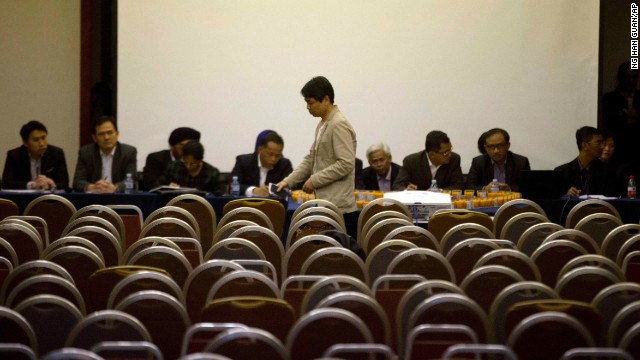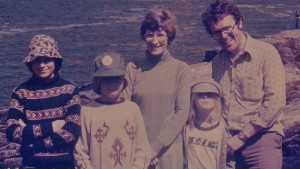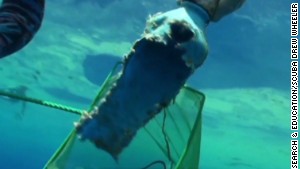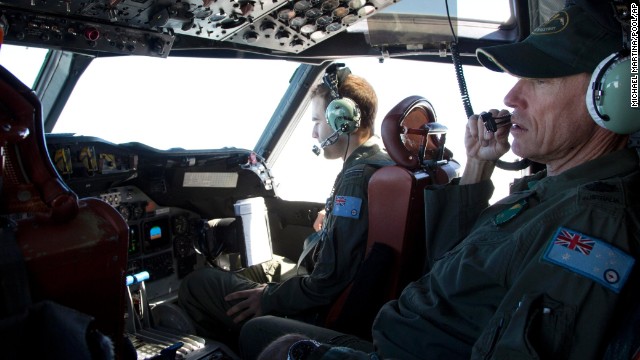Malaysia plane saga: Your questions answered
March 28, 2014 -- Updated 1650 GMT (0050 HKT)
STORY HIGHLIGHTS
- Australian authorities shift search area hundreds of miles to the northeast
- The shift is based on new calculations about how far the plane flew
- New area is closer to land and in an area with better weather than the old search zone
- Satellite photos taken over old area don't appear to show plane debris, Australian official says
(CNN) -- It's been nearly three weeks since Malaysia Airlines Flight 370 vanished. Malaysian authorities say the plane went down in the southern Indian Ocean. Search efforts are concentrated in an area far off Australia's west coast.
What's the latest?
There's been a huge shift in where searchers are looking for Flight 370, and planes sent to the new zone have found lots of objects. But what those objects are isn't known yet.
Wait, I thought everyone was confident the old search zone was the right place to look. What happened?




More math, apparently.
Based on radar and satellite data, investigators have concluded the plane was traveling faster than initially thought in the early part of its flight. Because of that, it burned through more fuel than first believed.
So, like a car driven by a leadfoot through city streets, the plane had less fuel for its long, desolate flight over the Indian Ocean. That means, authorities have concluded, that it could not have traveled as far south as they once thought.
They now say the data shows the plane probably went down in an area about 680 miles (1,100 kilometers) northeast of the previous search zone.
But what about all those floating objects spotted by satellites?
Forget about them, the Australians say.
"In regards to the old areas, we have not seen any debris," said John Young, general manager of emergency response for the Australian Maritime Safety Authority. "And I would not wish to classify any of the satellite imagery as debris, nor would I want to classify any of the few visual sightings that we made as debris. That's just not justifiable from what we have seen."
But couldn't currents have carried the debris there?
No way, according to University of Western Australia oceanographer Charitha Pattiaratchi.
Pattiaratchi modeled currents in the search zone and said objects floating in the water moved east, not south or west, and tended to stay trapped in eddies "barely leaving the search area."
"There is absolutely no connection, in terms of the debris between the two locations which are 1000 km apart," Pattiaratchi said in an e-mail.
He said currents are much milder in the new search zone, meaning that if the plane did go down in this new search zone, debris should be located in a smaller area because there is much less drift there.
Another oceanongrapher, Curt Ebbesmeyer, said objects would likely drift about 10 miles a day, and smaller objects that continue to float could reach the west coast of Australia in about three months.
Where is the new search area?
It's 680 miles (1,100 kilometers) to the northeast of where search operations had been focused. That puts it 1,150 miles (1,850 kilometers) off the west coast of Australia. That's about 400 miles (644 kilometers) closer to land than the previous area.




So what does this mean for efforts to find the plane?
Australian officials say the new search area is closer to land and in a gentler region of ocean, making for longer, safer and more consistent searches.
But it's still a huge area at 123,000 square miles (319,000 square kilometers) and will take some time to search.
"We're kind of starting from square one with a whole new search and a whole new set of premises," CNN aviation analyst Jeff Wise said Friday.
How many countries are involved in search efforts?
Malaysia is coordinating the search, which involves crews from six countries. Australia is leading the effort, based out of Perth, with China, New Zealand, the United States, South Korea and Japan contributing aircraft. China has also sent ships to help the search effort.
How are the families of those on board?
Family members are anguished as they wait for answers. One-third of the plane's passengers were Chinese, and Malaysian authorities' announcement Monday that families should give up hope that their loved ones were alive angered many Chinese.
"My heart can't handle it. I don't want to hurt my children," Cheng Li Ping told CNN as she waited in Kuala Lumpur, Malaysia, for evidence about what happened to her husband.
CNN's Ashley Fantz, Jethro Mullen and Michael Pearson contributed to this report.
We recommend
From around the web
ANA places bulk plane orders with Boeing, Airbus(Nikkei Asian Review)
The Kissing Report: Why the ‘French’ kiss?(Marie France Asia)
How To Stretch Out The Glutes(Learnist)
March 27, 2014 -- Updated 1956 GMT (0356 HKT)
They've been spotted and spotted again, those objects in the southern Indian Ocean.
March 27, 2014 -- Updated 0321 GMT (1121 HKT)
Erin Burnett talks to Captain Charles Moore about the conditions MH370 crews face in the Indian Ocean.
March 27, 2014 -- Updated 1947 GMT (0347 HKT)
Former Malaysian Airlines CEO tells says the pilot of missing flight MH370 was an excellent pilot and a gentleman.
March 28, 2014 -- Updated 0008 GMT (0808 HKT)
CNN's Erin Burnett talks with the partner of missing Malaysia Airlines passenger Philip Wood.
March 25, 2014 -- Updated 1223 GMT (2023 HKT)
One thing's missing from the official version of what happened to MH370, say some experts and family members: hard evidence.
March 27, 2014 -- Updated 1154 GMT (1954 HKT)
The objects are "potentially linked" to Flight 370, Thai state-run broadcaster MCOT said Thursday.
March 27, 2014 -- Updated 1956 GMT (0356 HKT)
They've been spotted and spotted again, those objects in the southern Indian Ocean.
March 26, 2014 -- Updated 2012 GMT (0412 HKT)
Jack got a text from Malaysia Airlines claiming his sister had died on Flight 370. This is what he texted back:
March 28, 2014 -- Updated 0038 GMT (0838 HKT)
The loved ones of passengers on Malaysia Airlines 653 have been waiting for 37 years.
March 27, 2014 -- Updated 1323 GMT (2123 HKT)
When TWA Flight 800 exploded off Long Island in 1996, it took more than a year to recover the bodies of all 230 passengers and crew.
March 27, 2014 -- Updated 1155 GMT (1955 HKT)
The emotional public reaction has added pressure on the Chinese government.
March 26, 2014 -- Updated 2233 GMT (0633 HKT)
New satellite images show 122 objects floating in the southern Indian Ocean, not far from other satellite sightings that could be related to the plane.
March 26, 2014 -- Updated 1640 GMT (0040 HKT)
Investigators in Malaysia are looking at all clues -- including the possibility of a cargo fire.
March 27, 2014 -- Updated 0507 GMT (1307 HKT)
Browse through photos taken by CNN journalists covering the missing Flight 370 story.
March 25, 2014 -- Updated 1757 GMT (0157 HKT)
Some families received the first piece of bad news about their loved ones on Flight 370 over text -- a bad idea, experts say.
March 25, 2014 -- Updated 1903 GMT (0303 HKT)
Satellites, planes and ships have been deployed to scour huge swathes of ocean for clues of the vanished plane -- here's how it all works.
March 25, 2014 -- Updated 1738 GMT (0138 HKT)
How did new number crunching confirm the Boeing 777's path?
March 25, 2014 -- Updated 0247 GMT (1047 HKT)
Amid the void of information on their fates, it seems at times that the passengers and crew of MH370 have been reduced to a number.
March 17, 2014 -- Updated 1318 GMT (2118 HKT)
This is what we know about the 50-year-old pilot-captain and his 27-year-old first mate.
March 24, 2014 -- Updated 1733 GMT (0133 HKT)
Any debris found could give investigators some clues as to what happened to the jetliner.
Most Popular
Today's five most popular stories








































No comments:
Post a Comment